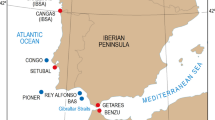Abstract
VERY little is known about the breeding habits of the Greenland whale. In the Greenland Sea, according to the log-books of Scoresby Sen., females with calves with them were seldom seen except in spring, west of Spitsbergen, north of latitude 78° or 79°, and in the end of July off the Greenland coast. Young whales, with whalebone 2-3 feet long—the smallest which are seen by themselves—were also seldom seen except in a high latitude west of Spitsbergen in spring. Where they go to in the summer months is not hard to understand: as my father says, “the old females with the younger whales of both sexes bury themselves in the polar ice, north of latitude 80°, after (or before) the end of June, where no ship can follow them; retreating in the autumn southwards as the ice makes in the north” (Scottish Fishery Board; Seventh Annual Report, part 3, p. 366).
This is a preview of subscription content, access via your institution
Access options
Subscribe to this journal
Receive 51 print issues and online access
$199.00 per year
only $3.90 per issue
Buy this article
- Purchase on Springer Link
- Instant access to full article PDF
Prices may be subject to local taxes which are calculated during checkout
Similar content being viewed by others
Author information
Authors and Affiliations
Rights and permissions
About this article
Cite this article
GRAY, R. Breeding Habits of the Greenland Whale. Nature 123, 564–565 (1929). https://doi.org/10.1038/123564b0
Issue Date:
DOI: https://doi.org/10.1038/123564b0
Comments
By submitting a comment you agree to abide by our Terms and Community Guidelines. If you find something abusive or that does not comply with our terms or guidelines please flag it as inappropriate.



